Welcome back! If you’ve landed on this blog post, I think it’s safe to assume that you’re as enamored by the mesmerizing Rann of Kutch as I am… or should I say.. ‘was.’ Very few have heard of it – the Great White Desert in Gujarat… a vast stretch of salt flats that go as far as the eye can see and appear to touch the sky at the horizon. On a full moon night, the white salt grains sparkle like silver; and during sunrise or sunset, the plains take on hues of purples and oranges – outworldly sights, both times!
It’s no wonder then that the Rann Utsav (or the Desert Celebration) is on most travellers’ agendas between November to February. It was on mine too, for years, until I ticked it off the bucket list last month. But was it worth the hype? Not really – I’ll tell you all about it. Read on.
View this post on Instagram
RANN OF KUTCH TRAVELOGUE
FROM MUMBAI TO BHUJ
Plans to visit the Rann of Kutch over the last 2-3 years never materialized, and, like most of my travels, this one was quite spontaneous, too. We decided to visit merely 24 hours before embarking on a road trip from Mumbai to Bhuj, a city in the district of Kutch – the details of which are mentioned in an earlier blog post. We entered our hotel in Bhuj (the first one we walked into) at 11:30 PM, after 18 hours of driving, and luckily, found some food in a small restaurant that was about to close nearby. Most restaurants were already shut by then.
View this post on Instagram
The next morning, Day 1, we started off exploring Bhuj pretty late in the day, after catching up on work from the hotel – digital nomad things, and all that. We took it easy, merely exploring the local markets and the handicraft stores such as Khamir Craft Resource Centre. On Day 2, we checked out some more handicraft villages, namely Bhujodi (which was amazing) and Nirona, which we heard was great, but was pretty deserted, with no people or handicrafts to be seen.
After lunch and an hour of rest at the hotel, we checked out the Ramkund Stepwell and Swaminarayan Mandir, a gorgeous white marble temple that we reached a little before sunset.
View this post on Instagram
I’ve already written about everything you need to know about this city in my Travel Guide to Bhuj, so you can learn more about what to eat, where to stay et al.
View this post on Instagram
FROM BHUJ TO MANDVI
On Day 3 of our trip, we checked out of our hotel and headed off to see the city’s jewels – the Aina Mahal and Prag Mahal, which took up the entire morning, but it definitely was the best thing to do in Bhuj! By afternoon we found ourselves setting off to Mandvi (after having road-side Dabeli for lunch). Mark my words, every day was spontaneous – I knew the areas around Bhuj more or less because like I said, I planned to visit several times, but we were just winging it from day to day, with no itinerary of sorts.
After about an hour of painless driving, we found ourselves looking for a hotel in Mandvi – not a very pleasant experience. My Travel Guide to Mandvi tells you more about that, as well as the things to do, where to stay, and what to see. We didn’t need much time to explore this little seaside town in Gujarat, a day was more than sufficient, even for the slowest of travelers. The only attraction worth checking out was the Vijay Vilas Palace, a breathtaking architectural beauty.
View this post on Instagram
On the evening of our arrival in Mandvi, we spent the majority of our time looking for accommodation, an hour at the beach, and then worked at our hotel until late evening, with a break for dinner.
The next morning, which was Day 4 of our trip, we hopped down to the beach at dawn in the hopes of spotting flamingos but didn’t see any, since we later learned that they migrated to Manvdvi in July. On the way back to the hotel, we lucked out and stumbled upon a gorgeous mosque – the Mazar–e-Noorani, of the Bohri Muslim community. We then headed to our hotel, packed up our stuff, and checked out after a quick breakfast of fafda jalebi at a stall outside the hotel. Mandvi may have seemed rushed, but there was literally nothing else to do there.
FROM MANDVI TO RANN OF KUTCH
By noon, we had driven back to Bhuj and were at the city centre – by now, an area we knew well. We had initially decided to stay in Bhuj for another day, but since we had half the day to spare and nothing more to do in the city, we carried on driving towards the Rann of Kutch – a distance of about 80 kms. No sooner than we left Bhuj behind us we found ourselves driving past desert scenes of sparse vegetation and of men herding camels, for close to an hour.
On entering the Rann of Kutch, you’ll begin seeing small hotels cropping up. If you’re planning to stay at the Rann of Kutch for a night or two, consider choosing one of these simple hut-like properties to plop your bags in.
For those driving to the Rann of Kutch, keep in mind that there are no petrol pumps here – the nearest being over 55 kms away. Secondly, there are no ATMs here either. Inquire at the dhabas near the tent city and they’ll point you to someone who sells petrol. Be ready to shell out Rs. 20 extra per litre, and carry cash.
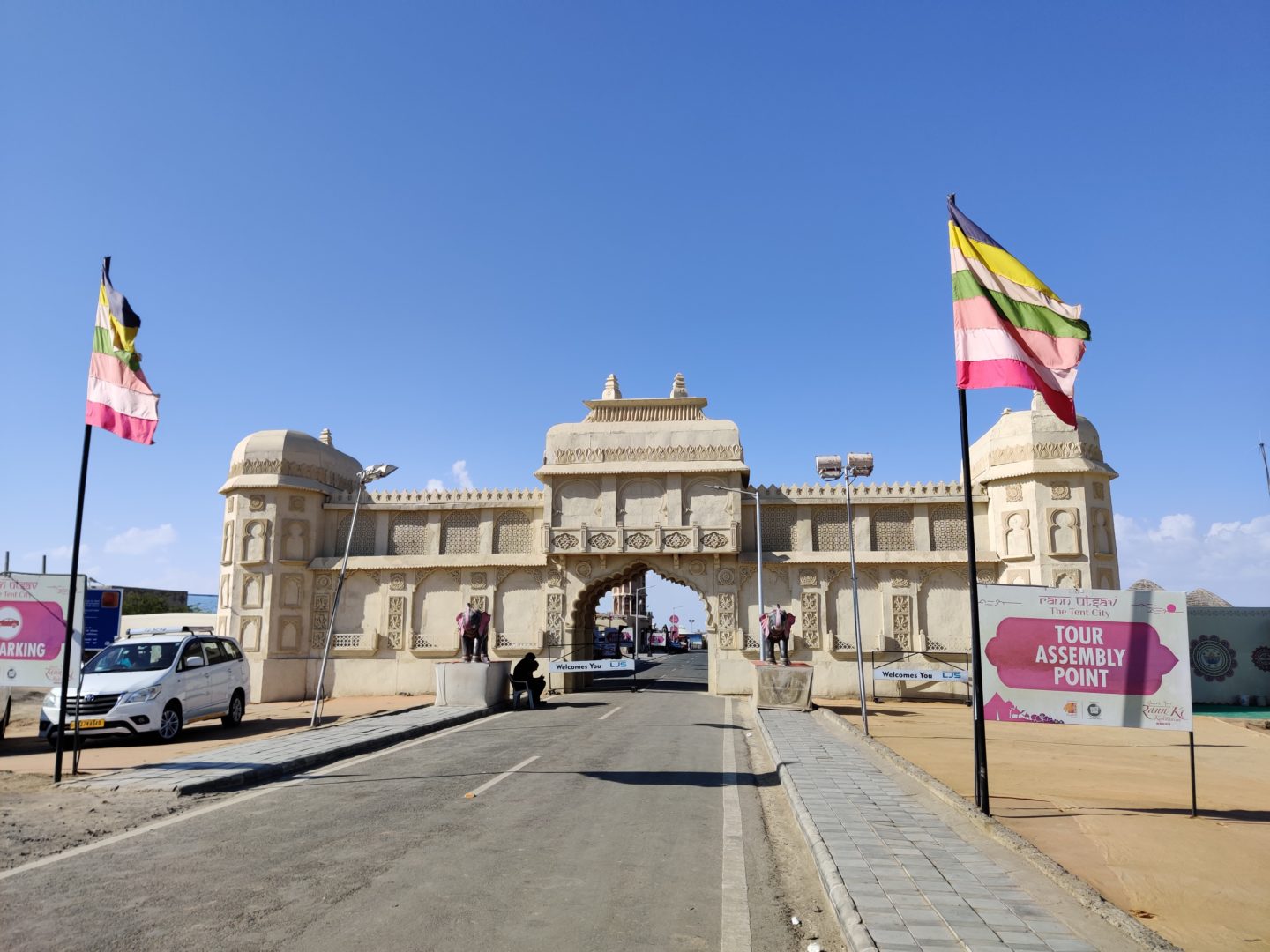
The tent city in Dordo, set up by the govt of Gujarat, is the closest accommodation you will find to the White Desert, but staying here is insanely expensive – ranging from anywhere between Rs. 5500 to Rs. 10,000 per person for a double or triple sharing tent. Meals are included in the price and entertainment in the form of cultural performances happen on a daily basis, giving you a glimpse into the culture of Gujarat.
This, along with the convenience of proximity to the White Dessert make it a deal that many consider worth spending on. While I don’t think twice about spending on experiences, I didn’t fancy this one in the slightest.
After a quick lunch of delicious dal tadka and jeera rice at a roadside Dhaba near the tent city, we headed off to the Rann of Kutch area. Due to its proximity to Pakistan, this is a highly sensitive area with tight security. Individuals need to get a permit at the gate and if you’re driving down, you will need to get a permit for your car too – which is at Rs. 200 per day (which also grants you access to Kala Dungar, so keep your permit handy because it *will* be checked several times). After wrapping up these formalities, we were allowed to drive a few meters in and had to park (why the permit!?)
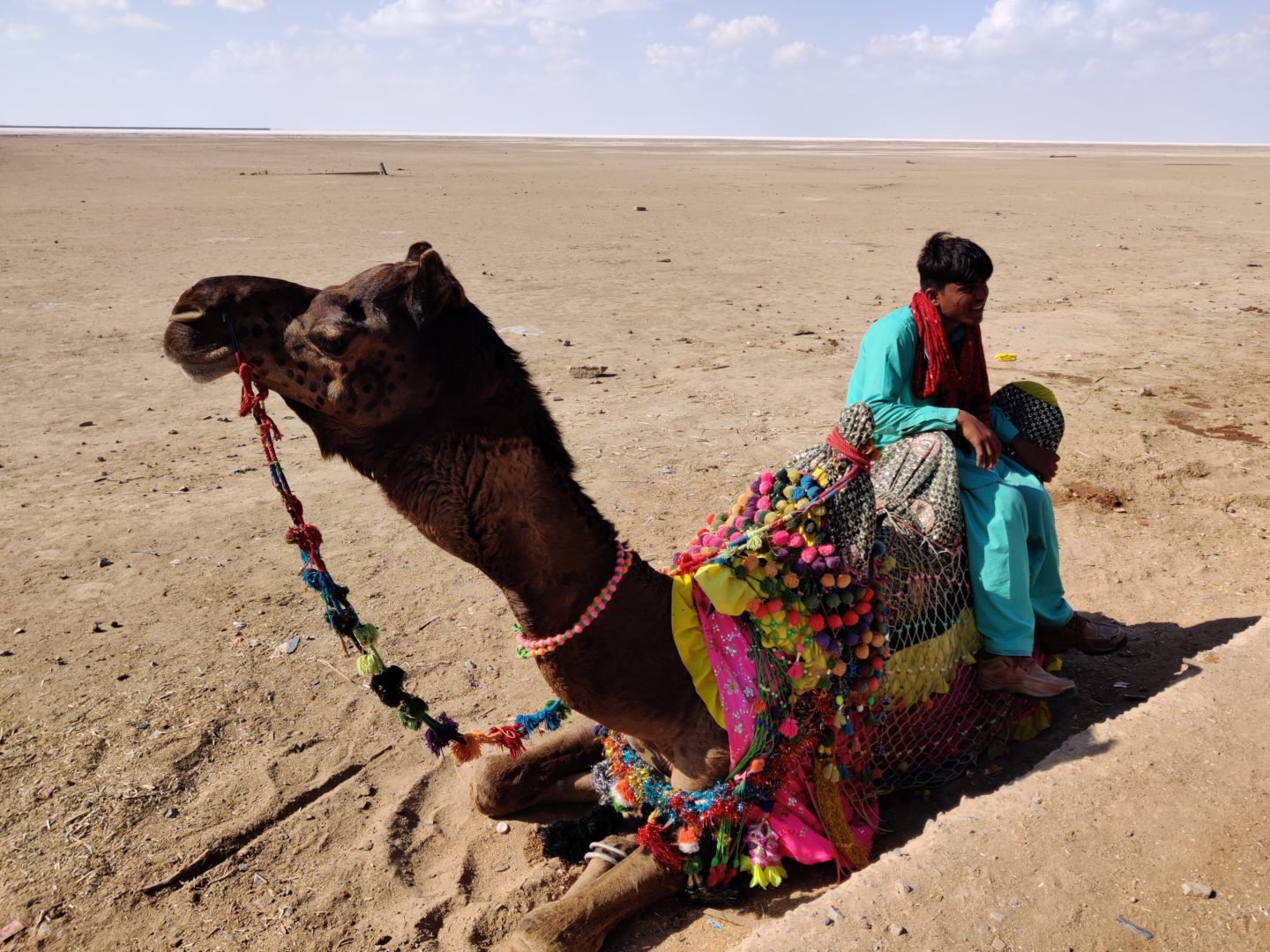
Here, hordes of decked-up camels and carts stand with their owners, ready to take you into the desert. Depending on the size of the cart, you would need to pay anywhere between Rs. 200 – and Rs. 1000 per person, then hop on with a bunch of other people and make your way to the White Desert. From here – the camel point, the white salt flats were nowhere to be seen – not even in the slightest.
You would need to disembark at the end of the camel ride and walk in any direction you please to find the salt flats – the closer you are, the browner the earth is, and the more you walk, the better your chances of finding pristine salt surfaces. If you visit towards the end of the festival, the slimmer your chances of seeing untouched white flats as they are marred with footprints, camel tracks, and more. Quite disappointing!
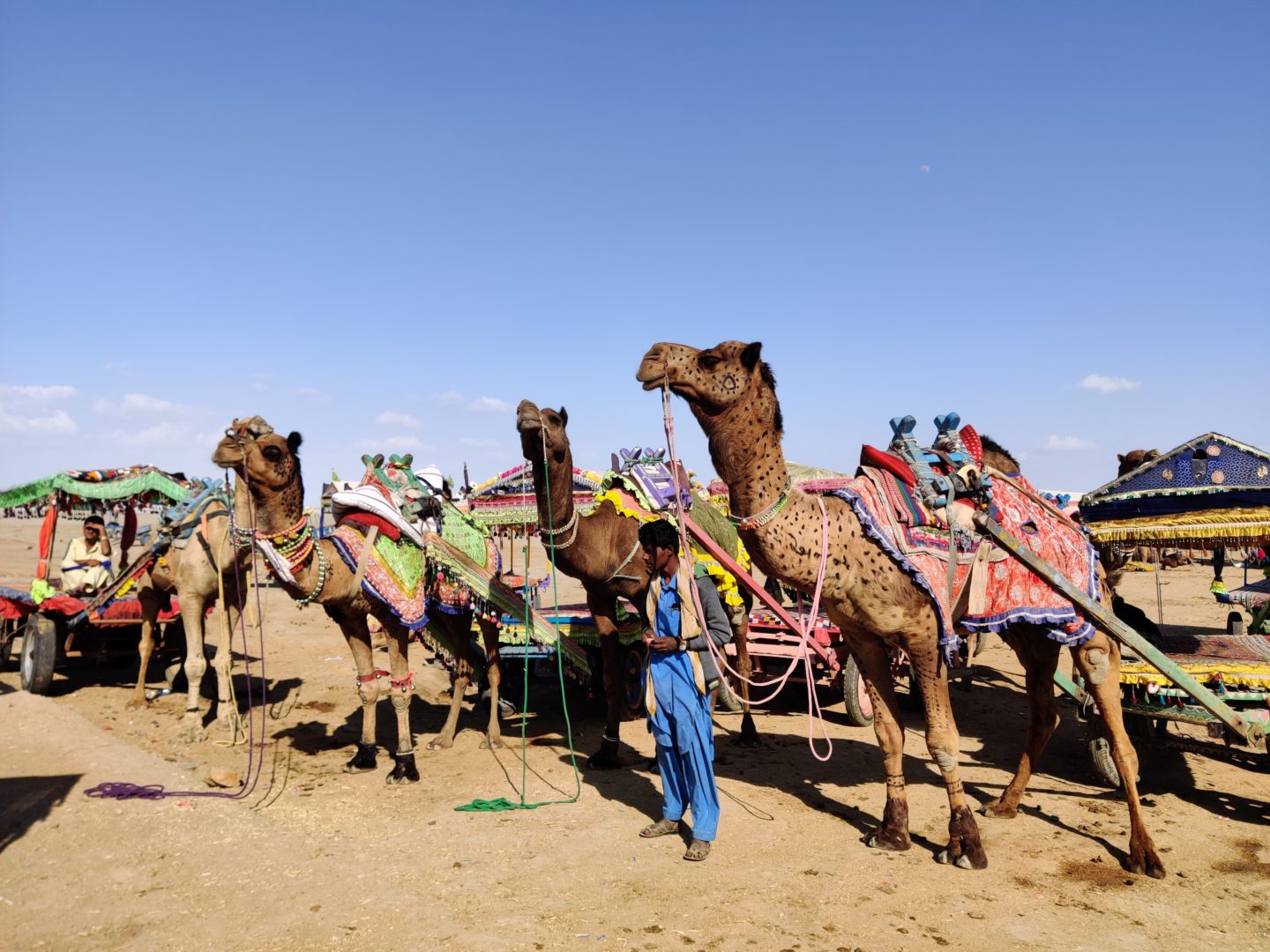
It didn’t take us long to find our way back to the car and head off – lucky we didn’t book a stay anywhere – the experience doesn’t warrant an overnight stay, or even a half-day stay, in my opinion. I had an inkling that this was a hyped-up experience, and kept expectations low, avoiding disappointment.
FROM THE GREAT WHITE RANN TO KALA DUNGAR
It was only 3 PM, and we hadn’t really planned on what to do next – are you seeing a pattern here (lol!). We’d vaguely heard of Kala Dungar, literally translating to the Black Hills, which was pretty close to the White Desert. We leisurely made the 90 km drive out of Rann of Kutch to Kala Dungar in close to 2 hours, again through pretty much barren land and a few small villages in between.
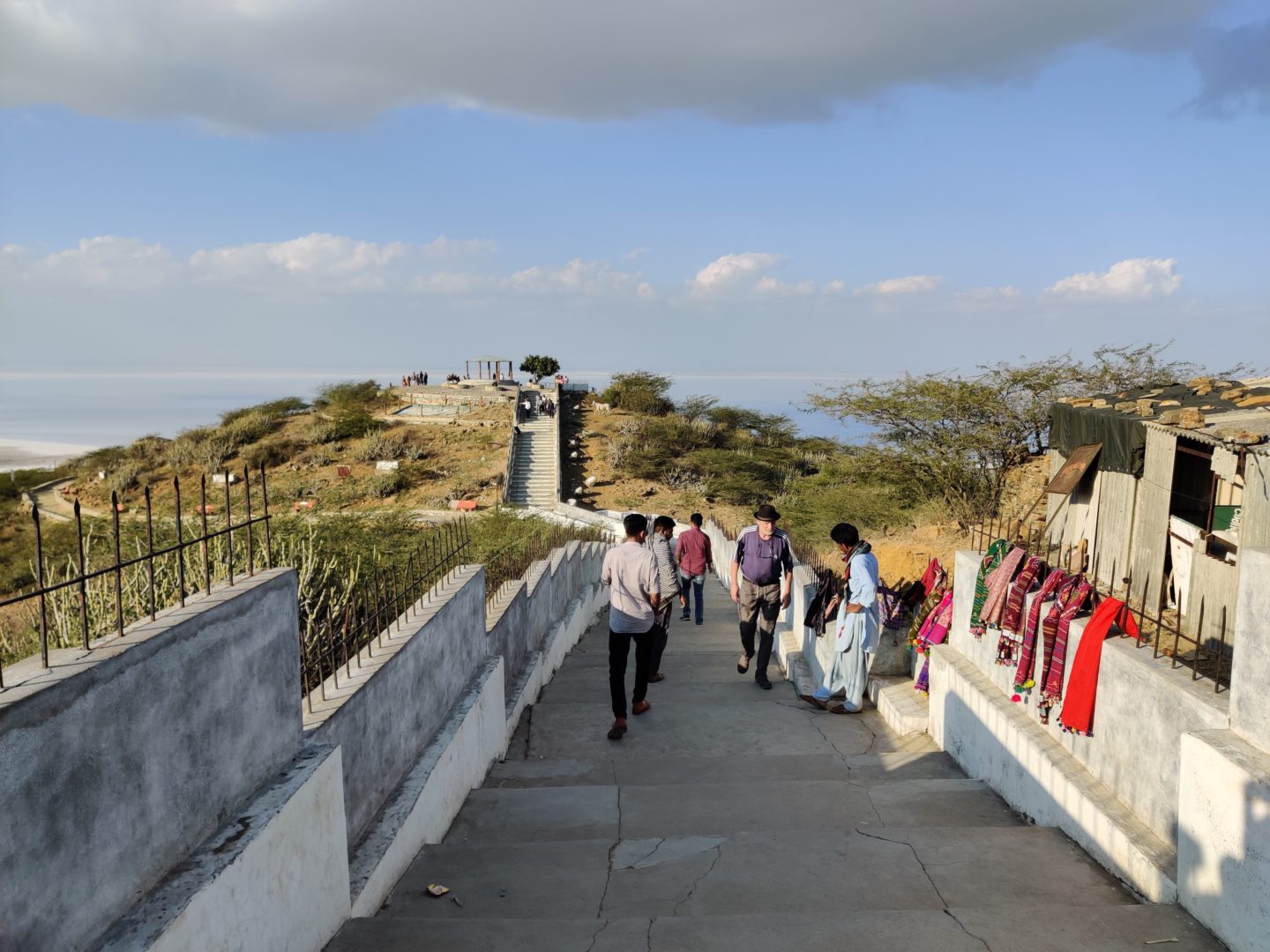
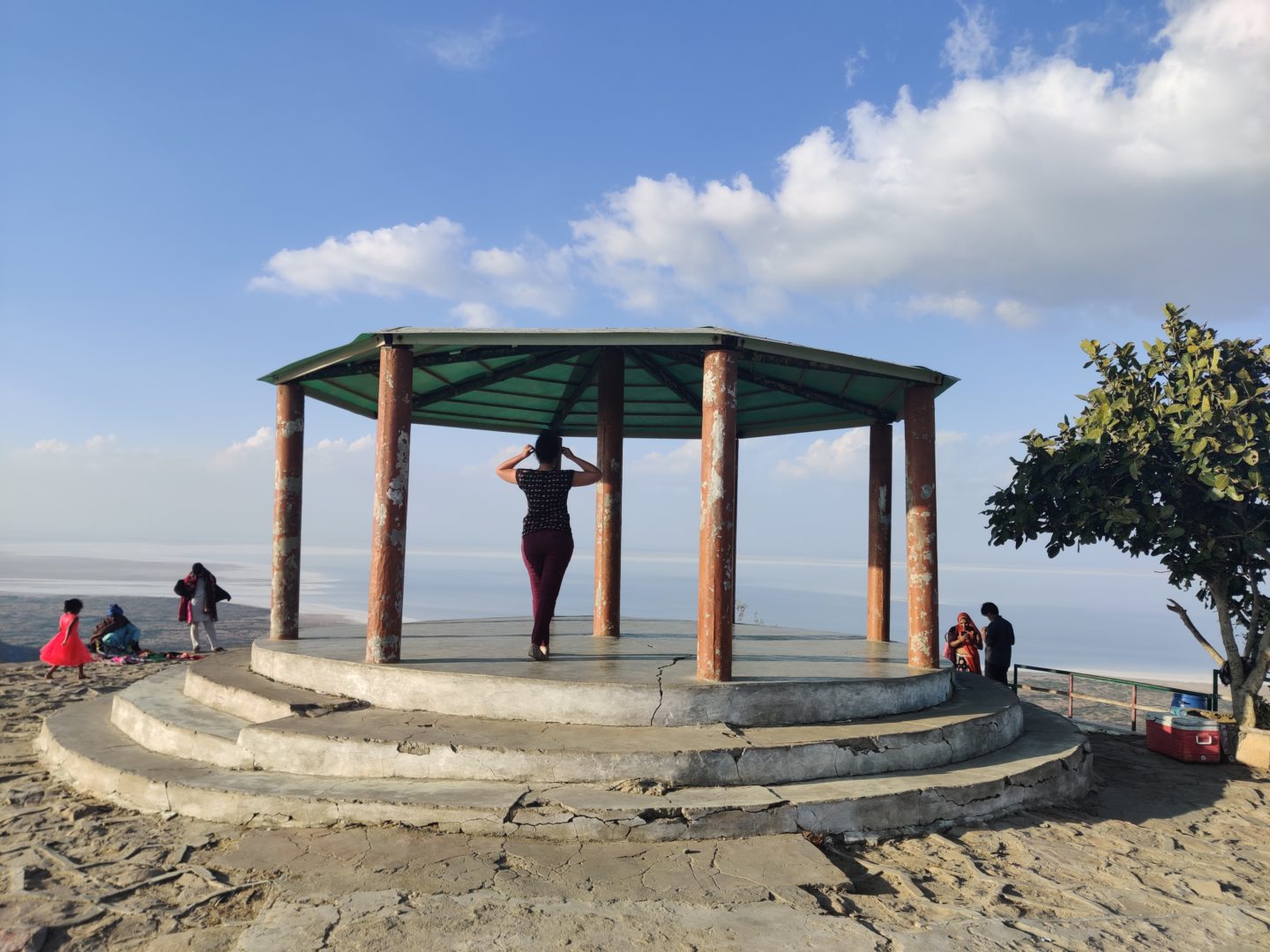
We parked our car and walked a short distance up the hill to Kala Dungar, the highest point in Kutch. The road was lined with vendors selling everything from Gujarati handicrafts, Rajasthani Juttis and apparel with mirror-work that looked very attractive, toys, roasted corn, sugarcane juice and more. Kala Dungar was absolutely gorgeous and since it was a ‘sunset point,’ it was pretty empty at 5 PM in the evening, with only 8-10 people around. Vendors consistently hounded us to don a turban and click photos, but they left us alone after in due time.
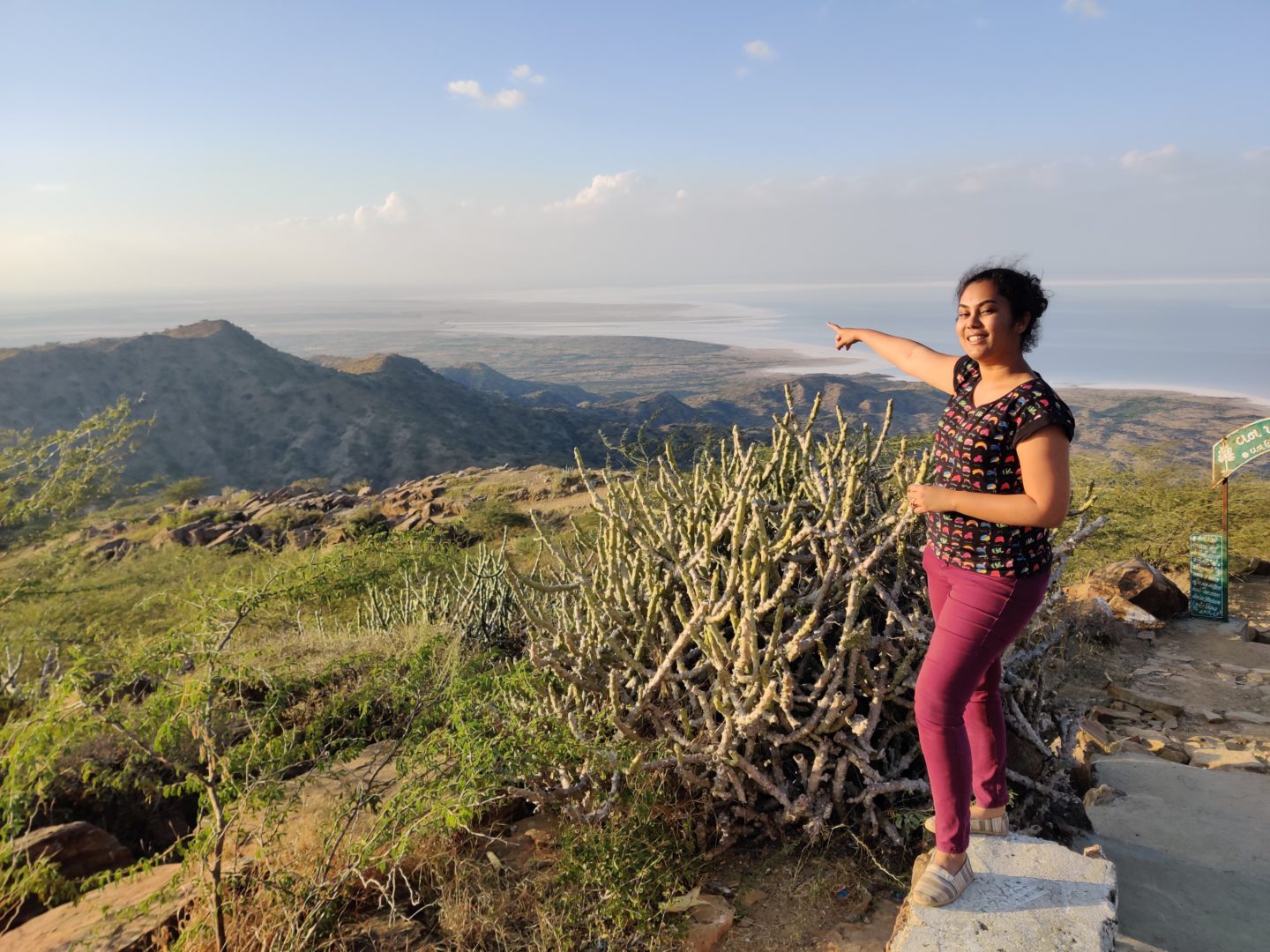
In front of us, on one end, was the azure blue Kutch Lake, laced with white salt around the edges, sharing its borders with Pakistan on one side and Dolavira on the other. Between us at Kala Dungar and the lake were rolling black hills. We grabbed a tiny cup of tea, sat down in silence and enjoyed the magnificent view and strong wind for almost an hour in absolute peace.
We didn’t wait until sunset, but as we descended down the hill at 6 PM, 2 bus-loads of tourists were making their way up to enjoy the sunset, and we were glad to have avoided them. Once again, our random plan worked out in our favour. Oh, before I forget, I should also mention that the washrooms here are terrible – avoid if possible.
On the way out, we passed the mysterious ‘Magnetic Hill’ in Kutch. We switched off the car and let it come to a halt. Within a couple of minutes, the car began to move forward – on what seemed like a flat surface, for around 100 meters – just as we had read online.
FROM KALA DUNGAR TO BHUJ AND DOLAVIRA
From Mandvi to Rann of Kutch and then to Kala Dungar… it had been a long, tiring day and as we made our way towards Bhuj again, we decided to stop at the first good hotel we saw. It was around 9 PM when we found Hotel Bhagwati on the highway, just after crossing Bhuj and we were delighted by the spotless rooms, comfy bed, good washroom and nice service. We ordered dinner from Bhagwati Restaurant on the ground floor but didn’t quite like the food.
The next day, Day 5, we headed out by 9 AM after working from the hotel room. The destination was Dolavira – on the little island of Khadir, an offbeat place to travel to in Gujarat that we heard about through a biker friend. It is a very prominent archaeological site, for it belonged to the Indus Valley Civilization.
Dolavira holds the ruins of the largest Harappan sites known to exist, and since it was inhabited for 1200 years (between 3000 BC to 1800 BC), excavations reveal much about life in those times through the city’s stepwell, sustainable use of water, and ingenuity of the town, which still amazes historians.
We drove on for 200 kms until we reached a long road with white salt marshes on both sides. While driving on for what seemed like an hour, we lucked out and spotted a sole flamingo in a patch of water in the desert, much to my delight. I stopped by the side of the road for a good 20 minutes, watching it wade through the water – and not a single car passed us the entire time.
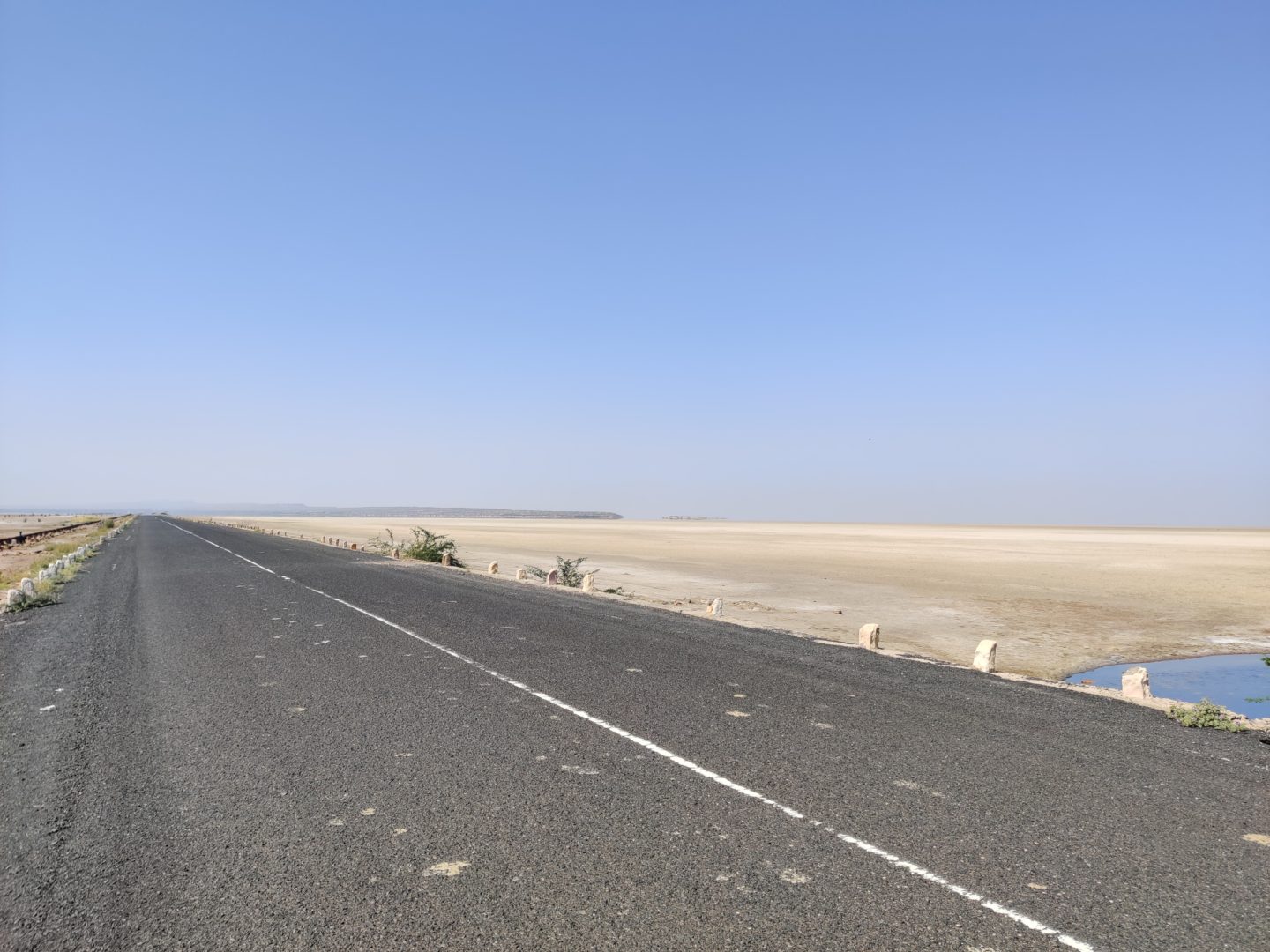
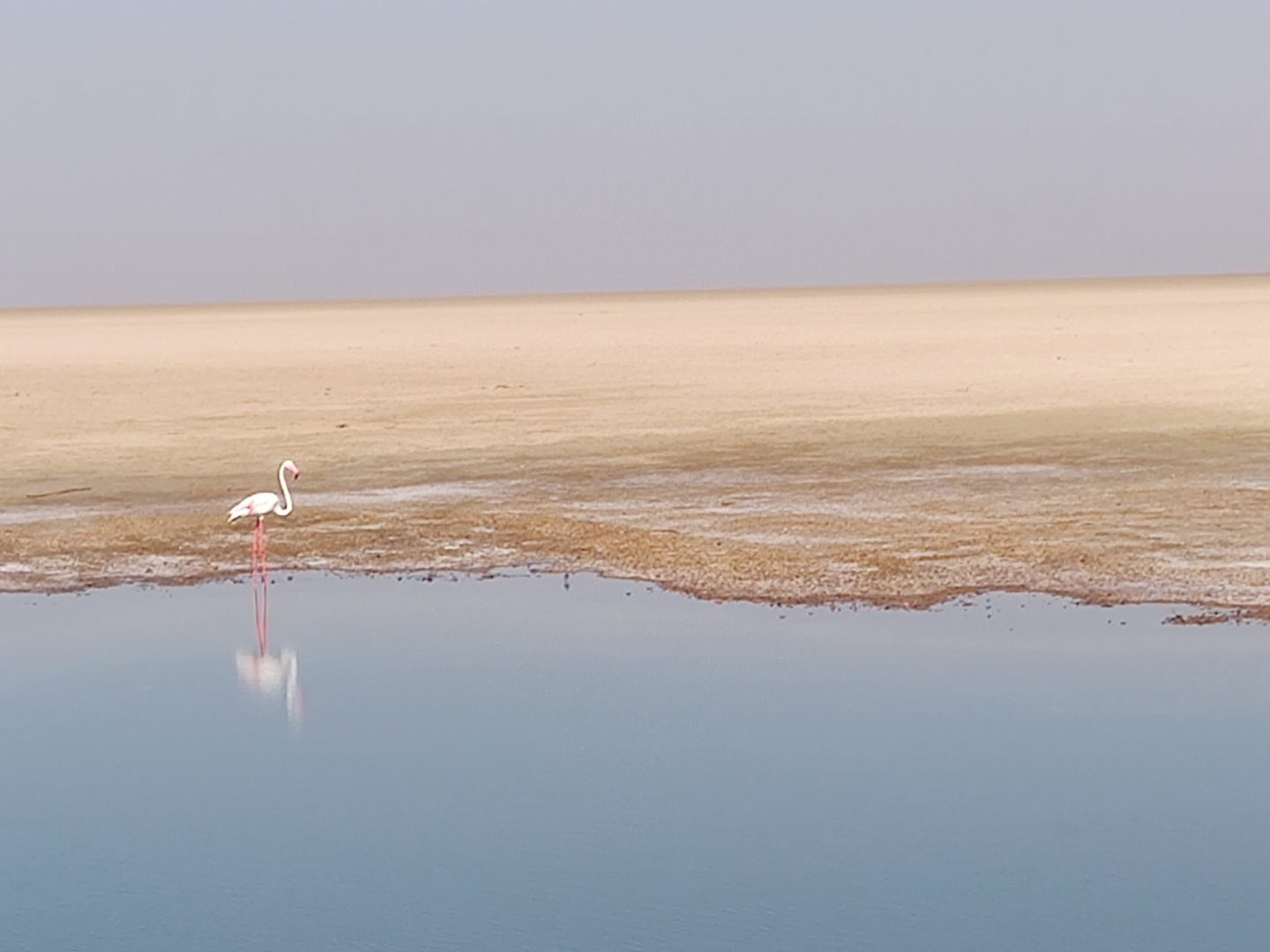
View this post on Instagram
Once in Dolavira, we drove around the tiny island, probably a little larger than Divar island in Goa – and found a small temple by the Kutch lake… the shores, as white as the photoshopped pictures of the Rann of Kutch. This was the same lake that we had seen yesterday from another vantage point, at Kala Dungar. Everywhere we looked, we saw white salt marshes with no hype, no pomp, no camels, no tourists. There are a few hotels here, which are again, quite expensive.
For lunch, we stopped at a government-run hotel. We had actually stopped there to inquire about stays (Rs. 6000 per night including all meals and a guide to the Harappan civilization) but decided against staying and merely had a delicious lunch in their restaurant instead.
At around 2 PM, when we had dined to our heart’s content, we headed to an unexplored area of the island. It was another road, with salt marshes on both sides for miles and miles (still in pristine condition in Feb, when the Rann of Kutch is in bad shape at the end of the tourist season).
To get on the road, you will need to get BSF permission from the Border Security Force office on the island. It may be a pain to do, but it’s completely 100% worth it. Keep in mind that once on that stretch of road, you won’t be able to step on the marsh as it is still wet from the lake drying up.
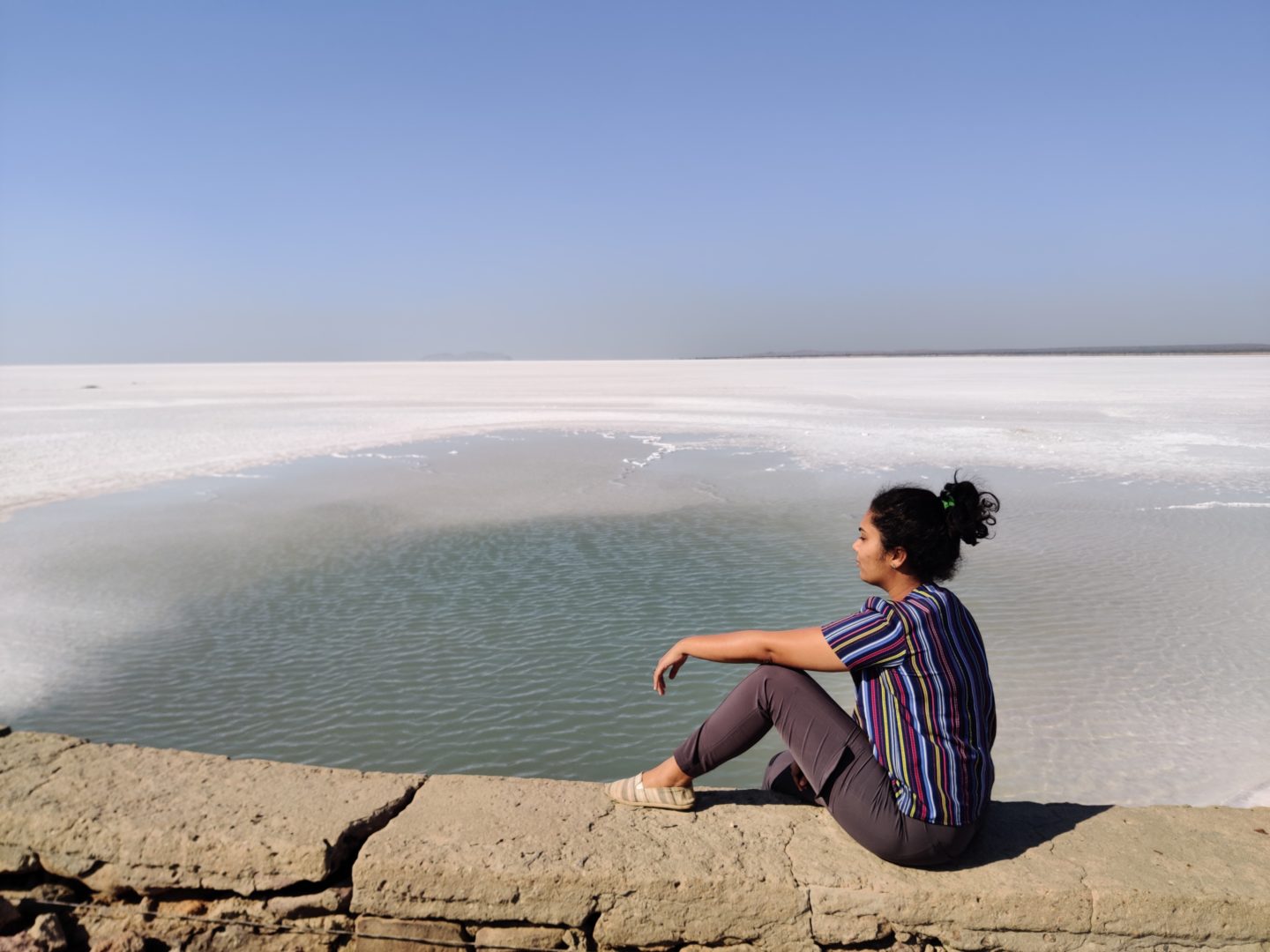
Isn’t it enthralling!? It was the fact that we couldn’t stay here till sunset or visit at night (due to the border security restrictions) that we decided not to stay at Dolavira.
FROM DOLAVIRA TO LITTLE RANN
We left Dolavira at around 5 PM and drove until night when we stopped at a place called Sankeshwar, which happened to be a religious place for the Jain community. After spending the night at a wonderful hotel called Hotel Grand Parshwanath (this trip was really lucky in terms of random, last-minute, super-cheap accommodation!), we set off the next morning to The Little Rann!
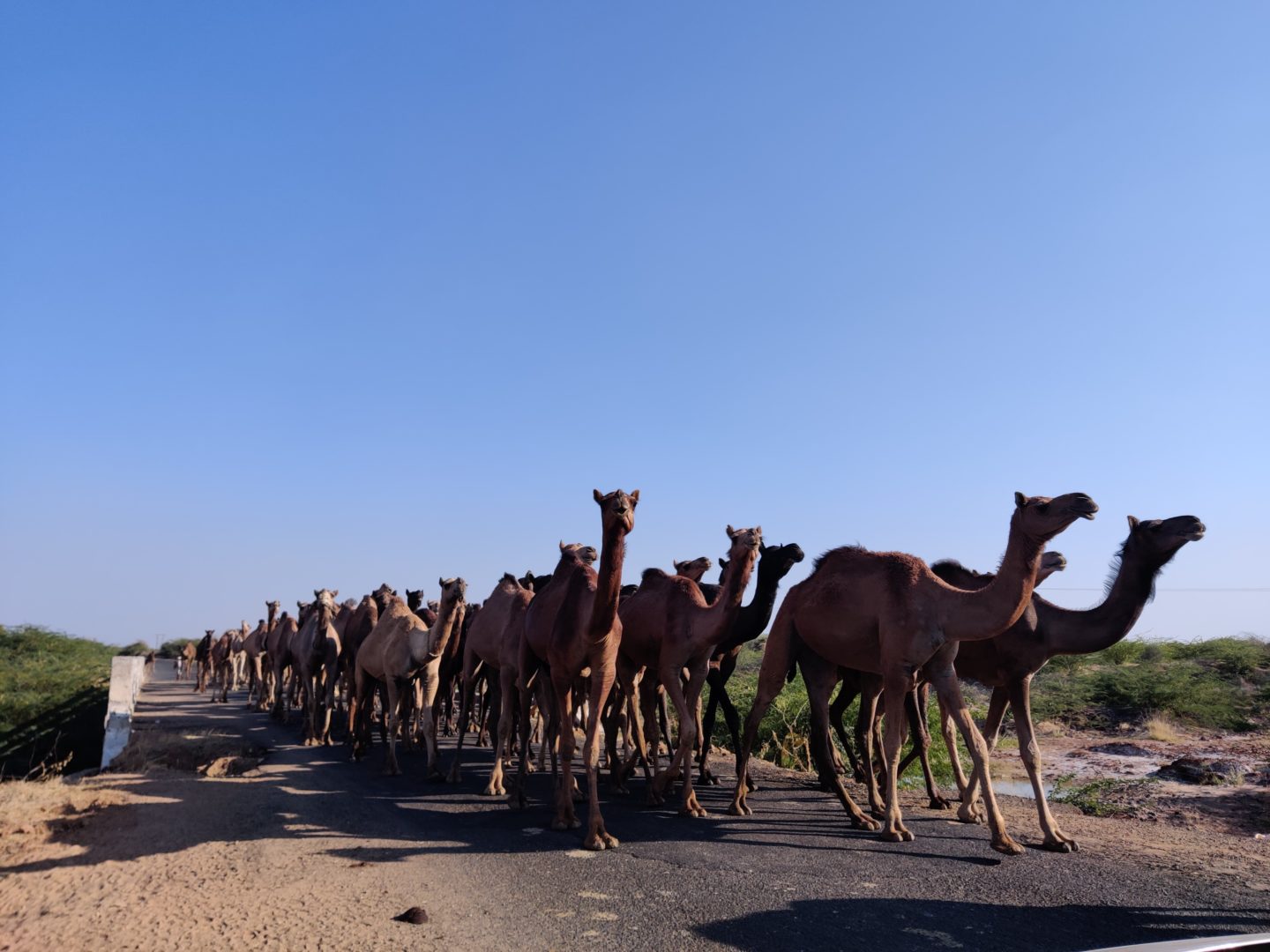
Very few people choose to visit the Little Rann because firstly, while it is still in the Kutch district of Gujarat, it is very far from the popular Rann of Kutch. And secondly, it comprises of hundreds of kilometres of bare, parched land and nothing more.
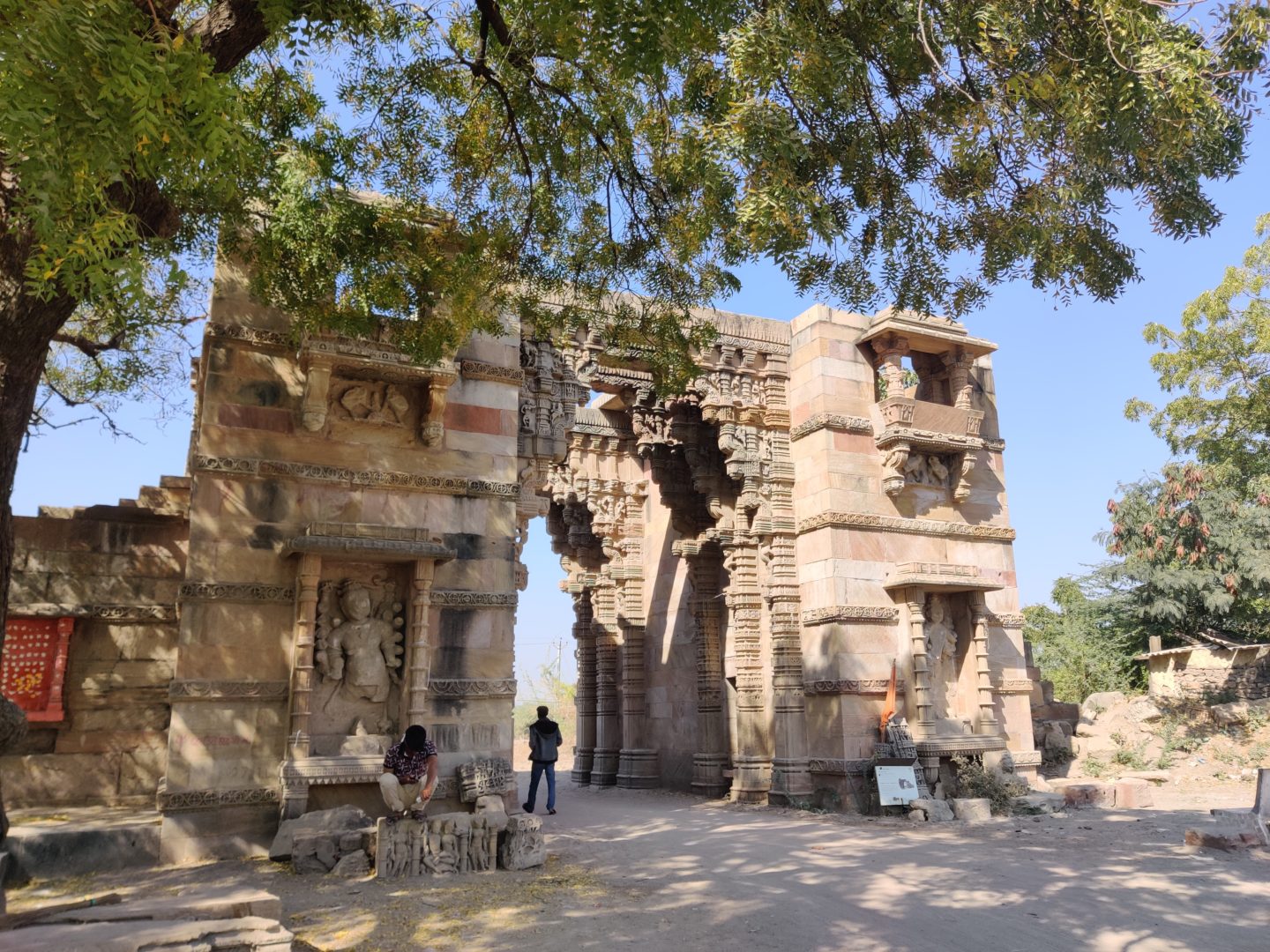
The landscape, however, is one of the most fascinating in the world. When the coastal wetlands dry up after the monsoons, the land cracks into large parched pieces, encrusted with salt. Though it looks bleak, it is rich in biodiversity, being home to local and migratory birds, the Indian wolf, desert fox and endangered species like the Wild Ass and Indian Bustard.
After a 6-hour drive spanning 250 kms, we turned into the Little Rann. No permissions or payments/tickets were needed… we just kept driving on dusty paths that got drier and more barren as we drove. Slowly, cracked land appeared – and the dry chunks of earth got bigger and bigger. There was absolutely nothing to see, but open land, the tyre tracks in front of us… and our own tyre tracks behind. After driving on this car-made pathway for close to 50 kms, we strayed off for a couple of hundred meters and couldn’t find our way back to the path. In some areas, the land was still soft underneath and looks deceivingly dry on the top – which can be quite scary because you’re miles away from any help!
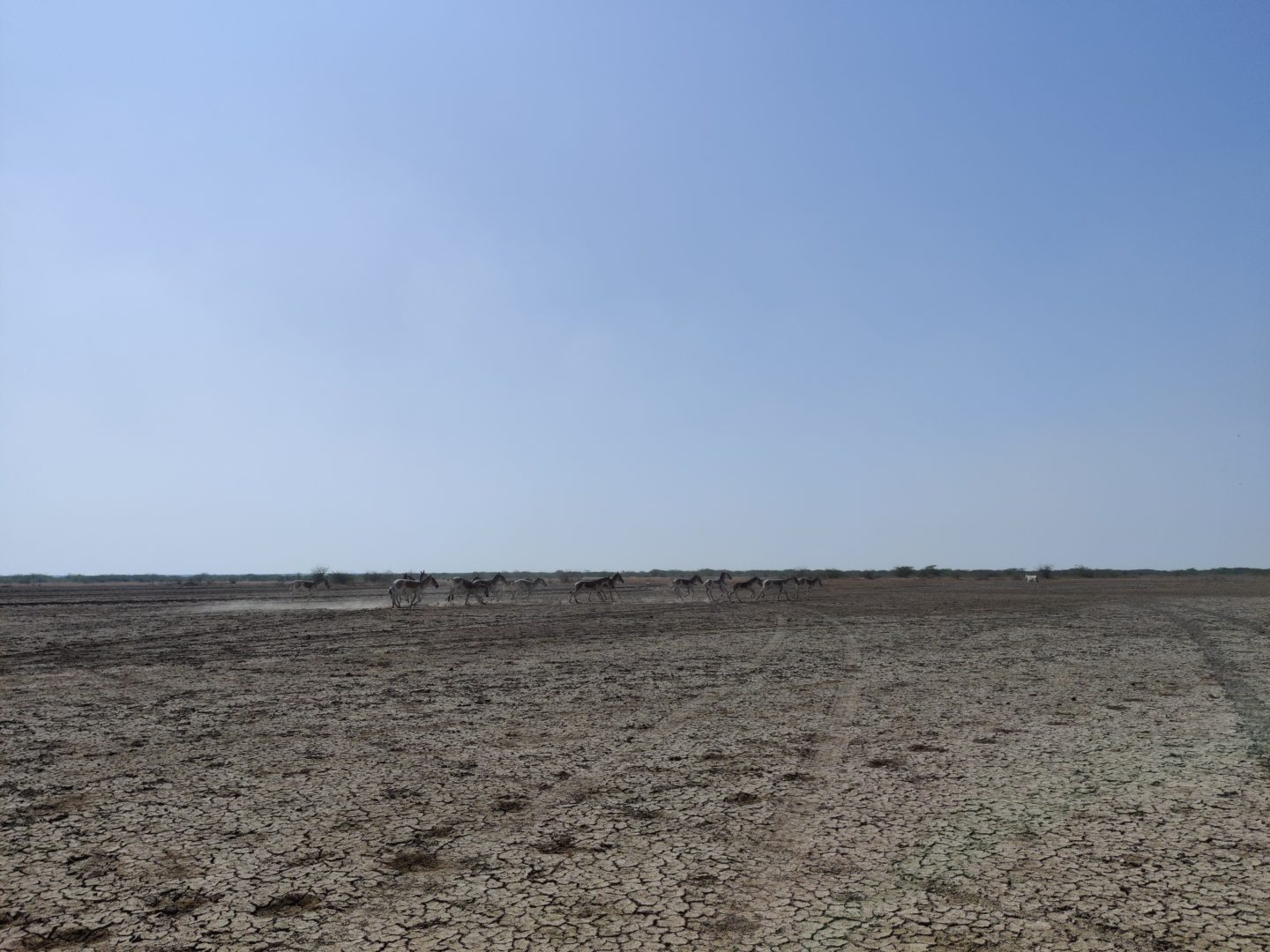
After driving through the Little Rann for 3 hours – and spotting animals in the distance, we turned around and headed back, following our own tracks. This, the Wild Ass Sanctuary at Little Rann is an experience I’ll never forget – and I’d highly recommend spending a morning or an afternoon here. Ensure you’re safely out by twilight or there’s little that anyone can do to get you out – with no network, no direction boards and no human life. You’ll be lucky if you spot another car on the entire journey.
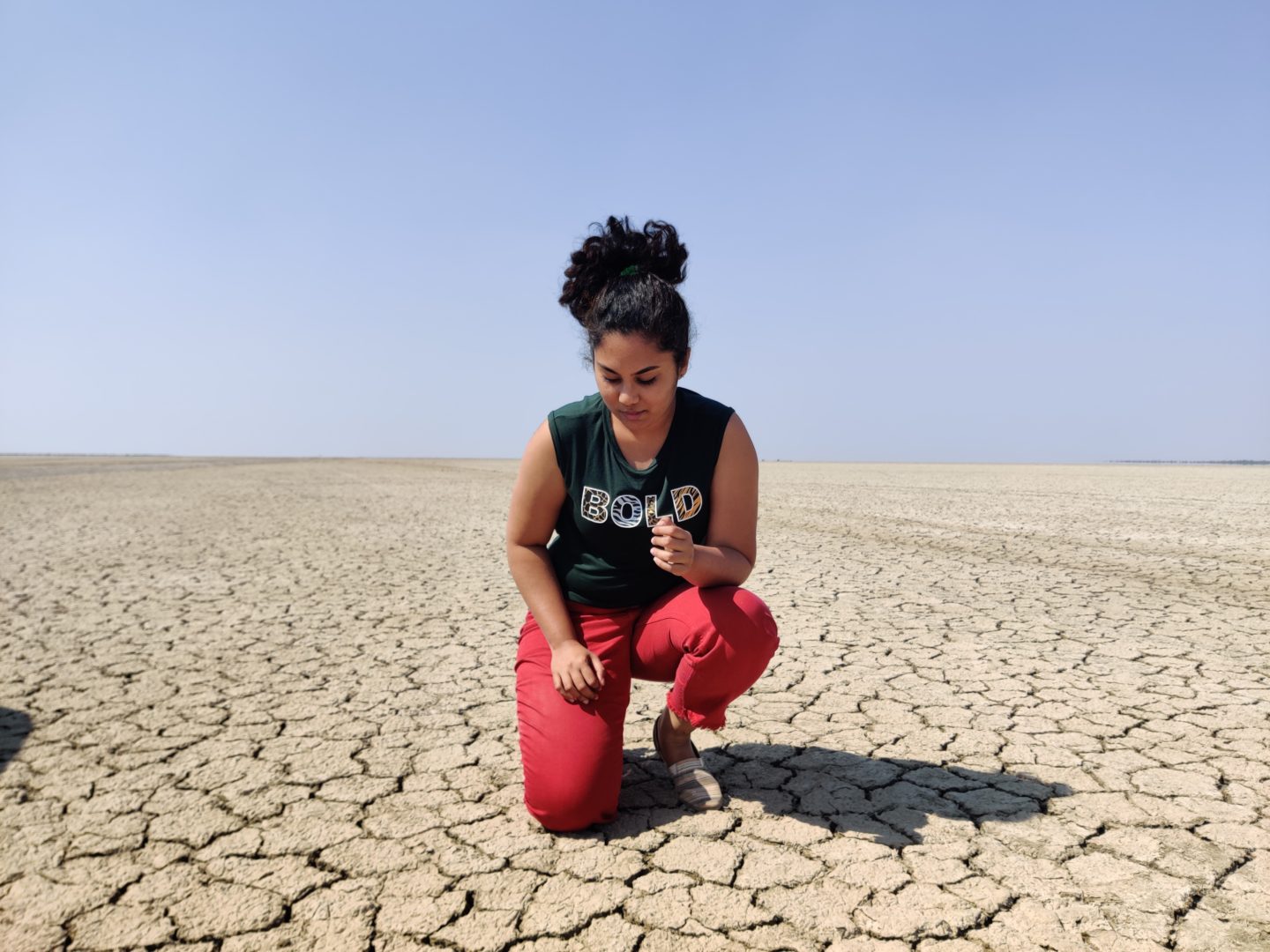
That wrapped up 7 days in the Kutch – and as soon as we got out of Little Rann, we began our drive back to Mumbai. At around 8 PM, we entered Vadodara and stopped for the night at Hotel Comfort Inn, a luxury property on the highway which is usually priced at Rs. 5000 +, that we snagged at Rs. 1800 on MakeMyTrip – right there in the reception of the hotel! Last-minute trips really do work better than planned ones, guys – let this travelogue be proof of that! After we had nice long showers and lounged around for a bit, we headed out for Pizza in Vadodara – vegetarian, of course… sigh… Gujarat!
The next morning, Day 8, we continued our drive back to Mumbai and were safely home by 5 PM. I’ll wind up this rather lengthy travelogue without further ado – but if you have any questions, feel free to comment or to reach out to me on Facebook, Twitter and Instagram. Onto the next adventure!

That’s a lovely post. There is so much to see apart from the salt pans of Kutch…
Author
Thanks for reading! I agree – there’s so much to see apart from the salt marshes, which were no big shakes at all. Highly overrated.
Hello Jade,
I found the article about The Kutch Travelogue to be a valuable and informative read. I am excited to visit Kutch soon and the information is very helpful in planning my trip.
It is a must-read for anyone who wants to make the most of their trip to Kutch.
Thank you!